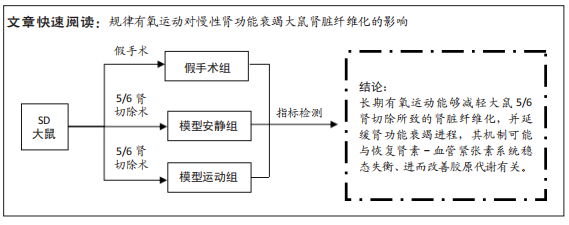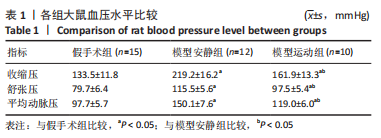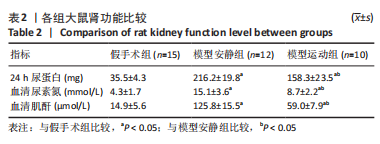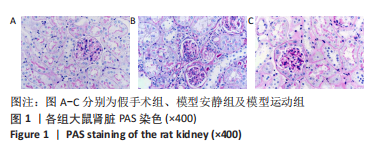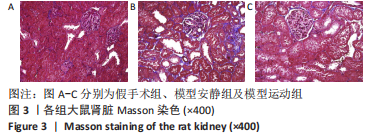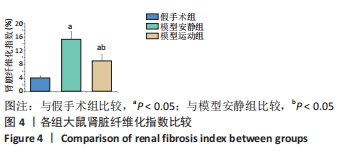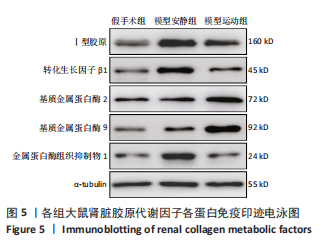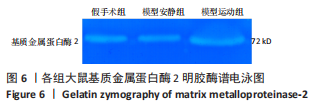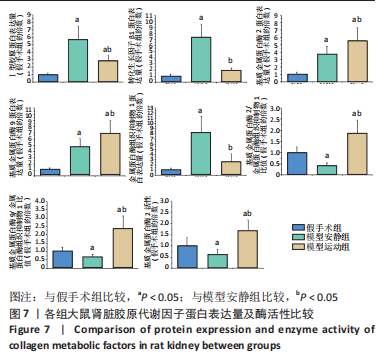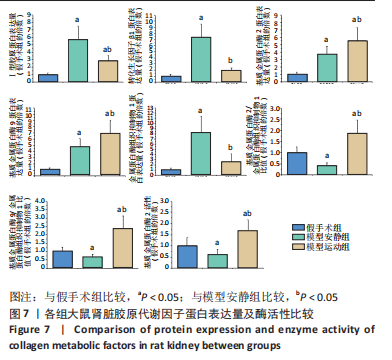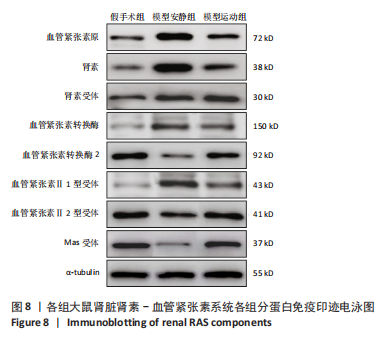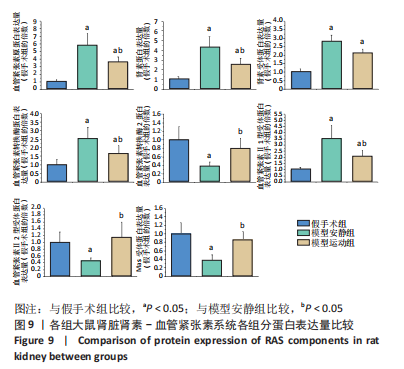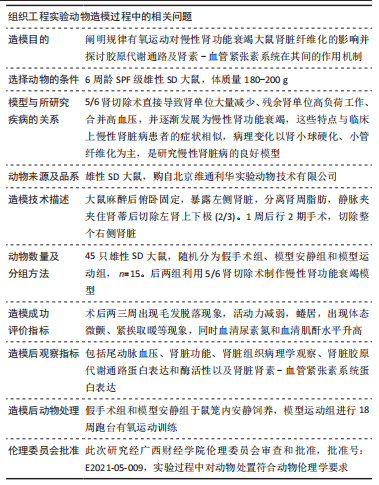[1] DJUDJAJ S, BOOR P. Cellular and molecular mechanisms of kidney fibrosis. Mol Aspects Med. 2019;65:16-36.
[2] MENN-JOSEPHY H, LEE CS, NOLIN A, et al. Renal interstitial fibrosis: an imperfect predictor of kidney disease progression in some patient cohorts. Am J Nephrol. 2016;44(4):289-299.
[3] MÜLLER-ORTIZ H, PEDREROS-ROSALES C, VERA-CALZARETTA A, et al. Exercise training in advanced chronic kidney disease. Rev Med Chil. 2019;147(11):1443-1448.
[4] VILLANEGO F, NARANJO J, VIGARA LA, et al. Impact of physical exercise in patients with chronic kidney disease: Sistematic review and meta-analysis. Nefrologia (Engl Ed). 2020;40(3):237-252.
[5] PEI G, TANG Y, TAN L, et al. Aerobic exercise in adults with chronic kidney disease (CKD): a meta-analysis. Int Urol Nephrol. 2019;51(10): 1787-1795.
[6] KOHZUKI M, KAMIMOTO M, WU XM, et al. Renal protective effects of chronic exercise and antihypertensive therapy in hypertensive rats with chronic renal failure. J Hypertens. 2001;19(10):1877-1882.
[7] LU H, KANAZAWA M, ISHIDA A, et al. Combination of chronic exercise and antihypertensive therapy enhances renoprotective effects in rats with renal ablation. Am J Hypertens. 2009;22(10):1101-1106.
[8] KANAZAWA M, KAWAMURA T, LI L, et al. Combination of exercise and enalapril enhances renoprotective and peripheral effects in rats with renal ablation. Am J Hypertens. 2006;19(1):80-86.
[9] TUFESCU A, KANAZAWA M, ISHIDA A, et al. Combination of exercise and losartan enhances renoprotective and peripheral effects in spontaneously type 2 diabetes mellitus rats with nephropathy. J Hypertens. 2008;26(2):312-321.
[10] 付常喜, 马刚, 李平, 等. 不同强度运动对自发性高血压大鼠肾脏纤维化的影响及作用机制研究[J]. 首都体育学院学报,2021,33(6): 638-648.
[11] 李爽, 李艳波, 师雅, 等. 糖尿病肾脏疾病中转化生长因子β作用机制的研究进展[J]. 中国糖尿病杂志,2021,29(12):941-944.
[12] 朱晓婷, 陈志强. 益气化湿通络方对实验性肾功能衰竭大鼠肾脏氧化应激损伤及纤维化的改善作用[J], 中国应用生理学杂志,2020, 36(1):67-72.
[13] BASSIOUNI W, ALI M, SCHULZ R. Multifunctional intracellular matrix metalloproteinases: implications in disease. FEBS J. 2021;288(24): 7162-7182.
[14] CABRAL-PACHECO GA, GARZA-VELOZ I, CASTRUITA-DE LA ROSA C, et al. The roles of matrix metalloproteinases and their inhibitors in human diseases. Int J Mol Sci. 2020;21(24):e9739.
[15] FU W, WANG Y, JIN Z, et al. Losartan alleviates renal fibrosis by down-regulating HIF-1α and up-regulating MMP-9/TIMP-1 in rats with 5/6 nephrectomy. Ren Fail. 2012;34(10):1297-1304.
[16] 刘菁, 曾筱茜, 程一鸣, 等. 肾素-血管紧张素-醛固酮系统抑制剂相关联合用药策略的降压疗效及肾脏保护作用[J]. 中国实用内科杂志,2019,39(5):470-473.
[17] PAZ OCARANZA M, RIQUELME JA, GARCÍA L, et al. Counter-regulatory renin-angiotensin system in cardiovascular disease. Nat Rev Cardiol. 2020;17(2):116-129.
[18] YOSYPIV IV. Renin-angiotensin system in mammalian kidney development. Pediatr Nephrol. 2021;36(3):479-489.
[19] PANDEY A, GAIKWAD AB. AT2 receptor agonist Compound 21: a silver lining for diabetic nephropathy. Eur J Pharmacol. 2017;815:251-257.
[20] ISHIGAKI S, OHASHI N, MATSUYAMA T, et al. Melatonin ameliorates intrarenal renin-angiotensin system in a 5/6 nephrectomy rat model. Clin Exp Nephrol. 2018;22(3):539-549.
[21] 付常喜, 李平, 秦永生, 等. 有氧运动抑制自发性高血压大鼠肾脏纤维化[J]. 现代预防医学,2020,47(13):2421-2425.
[22] 朱政, 付常喜, 马文超, 等. 有氧运动调控自发性高血压模型大鼠心脏重塑的机制[J]. 中国组织工程研究,2022,26(14):2231-2237.
[23] MEDEIROS RF, GAIQUE TG, BENTO-BERNARDES T, et al. Aerobic training prevents oxidative profile and improves nitric oxide and vascular reactivity in rats with cardiometabolic alteration. J Appl Physiol (1985). 2016;121(1):289-298.
[24] 孙旗, 徐琳, 叶朝阳, 等. 肾衰Ⅱ号方对5/6(A/I)肾切除慢性肾功能衰竭大鼠促红细胞生成素及铁调素25蛋白表达的影响[J]. 中华中医药杂志,2020,35(3):1512-1515.
[25] LU JR, HAN HY, HU J, et al. Mechanism research of Bu-Shen-Huo-Xue formula against renal fibrosis in rats with 5/6 nephrectomy via E-cadherin, α-SMA, and TGF-β1. Clin Nephrol. 2018;90(1):53-58.
[26] YANG DC, MA ST, TAN Y, et al. Imbalance of matrix metalloproteinases/tissue inhibitor of metalloproteinase-1 and loss of fibronectin expression in patients with congestive heart failure. Cardiology. 2010; 116(2):133-141.
[27] CHOI SY, CHANG HJ, CHOI SI, et al. Long-term exercise training attenuates age-related diastolic dysfunction: association of myocardial collagen cross-linking. J korean med sci. 2009;24(1):32-39.
[28] JOHNSON TS, HAYLOR JL, THOMAS GL, et al. Matrix metalloproteinases and their inhibitions in experimental renal scarring. Exp Nephrol. 2002; 10(3):182-195.
[29] SAMADI M, SHIRPOOR A, AFSHARI AT, et al. Chronic ethanol ingestion induces glomerular filtration barrier proteins genes expression alteration and increases matrix metalloproteinases activity in the kidney of rats. Interv Med Appl Sci. 2018;10(3):171-177.
[30] TAKAMIYA Y, FUKAMI K, YAMAGISHI S, et al. Experimental diabetic nephropathy is accelerated in matrix metalloproteinase-2 knockout mice. Nephrol Dial Transplant. 2013;28(1):55-62.
[31] DILAURO M, ZIMPELMANN J, ROBERTSON SJ, et al. Effect of ACE2 and angiotensin-(1-7) in a mouse model of early chronic kidney disease. Am J Physiol Renal Physiol. 2010;298(6):F1523-1532.
[32] AGARWAL D, ELKS CM, REED SD, et al. Chronic exercise preserves renal structure and hemodynamics in spontaneously hypertensive rats. Antioxid Redox Signal. 2012;16(2):139-152.
[33] CIAMPONE S, BORGES R, DE LIMA IP, et al. Long-term exercise attenuates blood pressure responsiveness and modulates kidney angiotensin II signalling and urinary sodium excretion in SHR. J Renin Angiotensin Aldosterone Syst. 2011;12(4):394-403.
[34] VAZIRI ND, BAI Y, NI Z, et al. Intra-renal angiotensin II/AT1 receptor, oxidative stress, inflammation, and progressive injury in renal mass reduction. J Pharmacol Exp Ther. 2007;323(1):85-93.
[35] OUDIT GY, LIU GC, ZHONG J, et al. Human recombinant ACE2 reduces the progression of diabetic nephropathy. Diabetes. 2010;59(2):529-538.
|
